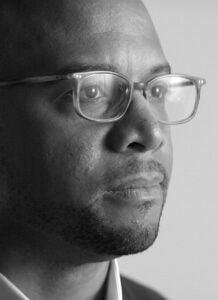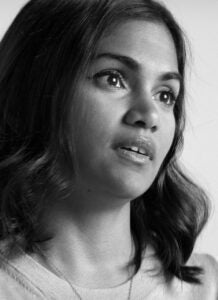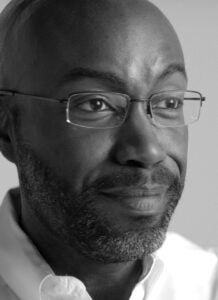On Aug. 9, 2014, Vernon Mitchell Jr., was on I-95, returning to his home in New Jersey, when he got a text from his sister.
“The text said, ‘They did it. They finally did it,’” Mitchell says. He texted back question marks.
She texted him an image of “someone laying on the ground. I later found out that was Michael Brown.”
Mitchell, now the academic engagement programs manager at Washington University and a lecturer in the American Culture Studies program in Arts & Sciences, was at the time a Visiting Fellow at Princeton University. But despite being a thousand miles away in New Jersey, as he learned more about what was happening that day in Ferguson, he was transported back to St. Louis County, and his first encounter with law enforcement.

A junior in high school, Mitchell was driving to a friend’s house for a victory party after a basketball game. He and his teammate were both wearing their varsity letterman jackets when they were pulled over by a county police officer.
“This was a White cop, [and we were] two African-American males,” Mitchell says. “He told me to get out of the car, that we fit the description of a stolen vehicle.” He remembers thinking, ‘It sounded phony … we wouldn’t rob somebody with our letterman jackets on — with our names on them.’”
Nevertheless, the officer “instructed us to get out of the vehicle. Had our hands on the car, patted us down. And the only thing I kept thinking about was, ‘OK, what did Daddy tell me to do? Because I’m not trying to die tonight, right?’ And so then I get incredibly angry at the same time, [thinking] I shouldn’t have to do this. We just won this basketball game, you know? We’re going to our friend’s house and now we’re dealing with this,” Mitchell says.
“The officer proceeded to sit in his car and bark some commands at us. We still have both of our hands on the side of the car. He walks back over to us and tells us to stand there. He takes the keys to the car and throws them in the grass on the side of the road and he drives off. I sat there with my hands on that little car for about five minutes. It felt like an eternity because I was so angry, because just … the dehumanization in that moment,” Mitchell says. “I was so mad.”
In Black families you got a degree before you got your high school degree. And that degree was about survival. And not if, but when you came into contact with law enforcement, what do you do?
Vernon Mitchell Jr.
So when he got that text from his sister, “all that stuff came back to me.” He thought, “Growing up around Ferguson, Florissant area, Berkeley, Kinloch … that could’ve been me.”
In addition to his formal education growing up in St. Louis, Mitchell got an informal education — about race.
“In Black families,” Mitchell says, “you got a degree before you got your high school degree. And that degree was about survival. And not if, but when you came into contact with law enforcement, what do you do?”
Blake Strode, executive director of the nonprofit civil rights law firm ArchCity Defenders, was taught similar lessons. “I grew up hearing pretty regularly … that there are certain streets that you don’t drive down because the cops are probably going to stop you,” he says. “It was always just in the background of living and being Black and growing up in St. Louis.”
Those warnings about the police were rooted in family experience. Strode says his father, “getting into our own home, had guns pointed at him and was suspected of not being at the right home at the right time. My mother was handcuffed and taken to a local municipal jail — and then magically any trace of it disappeared, because they didn’t actually have a reason for doing it in the first place. So most of the people I really care about know, from their own experiences, that this has been the common practice in St. Louis for a very long time,” Strode says.
“Growing up in St. Louis, there was always in the back of your mind being a Black youth that at any time you might be in a situation where you might not just be dehumanized, you might be destroyed by the state,” Mitchell says. “And that is heavy.”
White families in St. Louis also gave their children an informal education about race — but the lessons about who and what were dangerous were very different.
Paul Woodruff, executive director of Prosperity Connection and vice president of Community Development for St. Louis Community Credit Union, remembers growing up in Maryland Heights in St. Louis County and getting the message that, “if you go into the city, it is dangerous and there are Black people there,” he says. “My parents were never overt in saying anything terrible about anybody of a different color, persuasion, anything. But I just remember that there was always this undercurrent of things being dangerous. And so we would go to the Fox Theater, or we’d go to the zoo or somewhere, and my parents, other folks would say, ‘Well you have got to be careful, you’re going to the city.’ ”

Karishma Furtado, candidate in the Brown School’s Public Health Sciences PhD Program and the Research and Data Catalyst for Forward Through Ferguson, didn’t grow up White like Woodruff — she is Indian-American — but she received similar messages. “The city was definitely the big scary place that we in the county should keep our distance from,” she says. She was encouraged “to take advantage of the arts and the culture and the assets that are there, but be careful to be back by a certain time and to stay away from certain areas and to behave a certain way to make sure that you’re safe.”
But despite being only “one of probably ten people of color at my school,” those messages were never explicitly about race — they were always coded. “I don’t remember a single time having a conversation about race growing up in St. Charles County,” Furtado says.
Adelaide Lancaster didn’t grow up in St. Louis, but when she moved here for her husband’s medical residency at the Washington University School of Medicine in St. Louis, she also learned lessons about race in St. Louis.
“I noticed how divided our shared space was, our public space was,” she says. “I also received a lot of messages about where to go and where not to go. And I knew that those were coded and I knew that they were about race and it was startling how ubiquitous they were. I was told not to stop at a gas station on Kingshighway, just north of I-64, for no good reason. Just, ‘As you go near the hospital, make sure you never stop at that gas station.’ Nobody had any personal anecdotes or stories of things that had happened to them or even to other people,” says Lancaster, now the co-founder and director of Community & Collaboration for We Stories. “But there was a real sense of danger that was given to me by most of the people that I encountered.”
Jason Purnell grew up straddling the Black/White divide in St. Louis, and intuited clear messages about the difference between Creve Coeur, where he grew up in a Black family in a “mostly-White environment,” and in the City of St. Louis, where members of his extended family lived.

Purnell, associate professor at the Brown School and director of the Washington University initiative Health Equity Works, says that in his “earliest years … there wasn’t much explicit discussion of race,” but “as I grew older, I began to see the distinctions between myself and my classmates, and to notice just how isolated my sister and I were within that situation.
“But I was also a part of an extended family that still lived in the City of St. Louis. For a time, going to my grandmother’s house meant going to the Darst-Webbe housing projects just south of Highway 40. And then she moved to a house on St. Louis Ave. in 63106, so I had this experience of traveling into predominantly African-American communities, and doing so with a fluidity that I didn’t think much of. But as I grew older, I saw the different kinds of resources that were arrayed where I lived in Creve Coeur versus where I was visiting parts of my family,” Purnell says
“By the time you’re 10, you already know that there are several different Americas, there are several different experiences in St. Louis,” Mitchell says. “Understanding race growing up for me was always part of what made St. Louis St. Louis — this investment in this particular type of animus that animated the way that the city moved, the way that it felt.”
This was the context — two distinctly different lived experiences in the same region, two distinctly different narratives about race — in which Michael Brown Jr. was killed by Officer Darren Wilson.
“I think one of the things that you can tell in St. Louis, when you talk about what happened in Ferguson,” says Javad Khazaeli, a civil rights and immigration attorney, is what people understand about that context based on what they believe people were protesting.
“People who don’t understand what’s going on in St. Louis will tell you these protests started because Michael Brown was killed and left to basically rot in the street for hours,” Khazaeli says. “Whereas those of us who have been involved will say, ‘Michael Brown was the final bit of kindling that ignited years and years of frustration and oppression.’ People were just sick of it.”
Just days after Brown’s death, Erica Henderson, executive director of the St. Louis Promise Zone and vice president for community investment in real estate at the St. Louis Economic Development Partnership, protested with her son “because I could not believe that that would happen in our community,” she says.
“There was unity. There were tears. There was anger. There was fear,” she says of the protests. “You had mothers like myself holding on tight to their African-American boys. You had just a melting pot of people who said: ‘Enough already.’”
Brittany Ferrell, a candidate for a Master’s of Public Health from the Brown School at Washington University, and a co-founder of Millennial Activists United, says that before the Ferguson uprising, “Not enough people were paying attention or took seriously what is happening in our communities.”
She says while the protests were “often referred to as riots … that type of outrage that’s displayed in the form of very strategic and organized direct action is a language.” That language, Ferrell says, is “a way to communicate to the people around you that something is not OK — and this is not only a call to action, but this is a call for your attention.”
Those protests got the attention not only of St. Louis, but of the nation and the world.
“There was a spiritual awakening that people had been anticipating. Years ago, I and others that I had worked with said, ‘It’s probably going to take the city to burn before people pay attention to the pain that’s happening here,’” says Bethany Johnson-Javois, CEO of the St. Louis Integrated Health Network. “That’s exactly what happened.”
Christie Huck is executive director of City Garden Montessori School, a K-8 charter school in the Shaw neighborhood of St. Louis. “It was as if the young people in our community, in Ferguson, were demanding, finally, that we collectively listen and wake up to the realities of our city,” Huck says. “Which is that some people are living very comfortably and with incredible health, with incredible wealth, with incredible well-being, and many, many, many in our region are not. That those two things are actually directly correlated. That it is at the expense of people of color, of low-income people that many of us are able to live so comfortably.
“So I think Ferguson forced a moment of reckoning for St. Louis,” she says. “It also propelled St. Louis, I think, in a direction that cannot be reversed.”